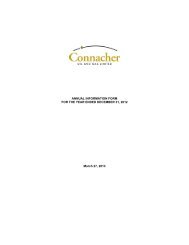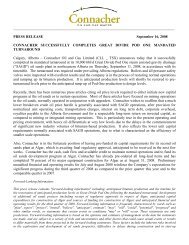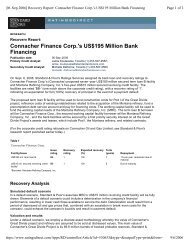ANNUAL REPORT 2011 - Connacher Oil and Gas
ANNUAL REPORT 2011 - Connacher Oil and Gas
ANNUAL REPORT 2011 - Connacher Oil and Gas
Create successful ePaper yourself
Turn your PDF publications into a flip-book with our unique Google optimized e-Paper software.
AR <strong>2011</strong><br />
PG 51<br />
Impairment of assets<br />
For the purposes of impairment analysis of the company’s assets, the key assumptions used in estimating cash flows are future commodity prices,<br />
expected production volumes <strong>and</strong> refinery throughput, cost structures <strong>and</strong> the outlook of market supply <strong>and</strong> dem<strong>and</strong> conditions appropriate to the<br />
local circumstances <strong>and</strong> environment. These assumptions <strong>and</strong> estimates are highly uncertain matters <strong>and</strong> are subject to change as new information<br />
becomes available. Changes in economic conditions can also affect the rate used to discount future cash flow estimates.<br />
Changes in assumptions could affect the carrying amounts of assets <strong>and</strong> impairment charges <strong>and</strong> reversals will affect net earnings (loss).<br />
Information about the carrying amounts of assets <strong>and</strong> impairments is presented in notes 9 <strong>and</strong> 10.<br />
Decommissioning liabilities<br />
Provisions are recognized for the future ab<strong>and</strong>onment <strong>and</strong> reclamation of petroleum, natural gas <strong>and</strong> refining properties at the end of their economic<br />
lives. The estimated cost is recognized in net earnings (loss) over the life of the reserves on a unit–of–production basis. Changes in the estimates<br />
of costs to be incurred, reserves or in the rate of production will therefore affect net earnings (loss), generally over the remaining economic life of<br />
petroleum <strong>and</strong> natural gas assets.<br />
Estimates of the amounts of decommissioning provisions recognized are based on current legal <strong>and</strong> constructive requirements, technology <strong>and</strong> price<br />
levels. Because actual outflows can differ from estimates due to changes in laws, regulations, public expectations, technology, industry st<strong>and</strong>ards,<br />
prices <strong>and</strong> conditions, <strong>and</strong> can take place many years in the future, the carrying amounts of such provisions are regularly reviewed <strong>and</strong> adjusted to<br />
take account of such changes. The interest rate used to discount the cash flows is reviewed quarterly.<br />
Information about decommissioning liabilities is presented in note 14.<br />
Taxation<br />
Tax provisions are recognized when it is considered probable that there will be a future outflow of funds to a taxing authority. In such cases, provision<br />
is made for the amount that is expected to be settled, where this can be reasonably estimated. This requires the application of judgment as to the<br />
ultimate outcome, which can change over time depending on facts <strong>and</strong> circumstances. A change in estimate of the likelihood of a future outflow <strong>and</strong>/<br />
or in the expected amount to be settled would be recognized in net earnings (loss) in the period in which the change occurs.<br />
Deferred tax assets are recognized only to the extent it is considered probable that those assets will be recoverable. This involves an assessment<br />
of when those deferred tax assets are likely to be realized, <strong>and</strong> a judgment as to whether or not there will be sufficient taxable profits available to<br />
offset the tax assets when they do reverse. This requires assumptions regarding future profitability <strong>and</strong> is therefore inherently uncertain. To the extent<br />
assumptions regarding future profitability change, there can be an increase or decrease in the amounts recognized in respect of deferred tax assets<br />
as well as in the amounts recognized in net earnings (loss) in the period in which the change occurs.<br />
Tax provisions are based on enacted or substantively enacted laws. Changes in those laws could affect amounts recognized in net earnings (loss)<br />
both in the period of change, which would include any impact on cumulative provisions, <strong>and</strong> in future periods.<br />
Financial instruments<br />
The company records its financial instruments at fair value on inception <strong>and</strong> at each reporting period depending on their subsequent classification.<br />
The calculation of the fair value requires judgment around expected outcome <strong>and</strong> is based on multiple variables such as the company’s credit risk <strong>and</strong><br />
interest rate spread. The estimated fair value of the financial instruments, by their very nature, is subject to measurement uncertainty.<br />
Other significant areas of judgment<br />
The estimates of net realizable value of inventory involve estimating future selling prices <strong>and</strong> accordingly, are subject to measurement uncertainty.<br />
The amounts for pension assets, obligations <strong>and</strong> pension costs charged to net earnings (loss) depend on certain actuarial <strong>and</strong> economic assumptions,<br />
which are subject to measurement uncertainty.<br />
Amounts recorded for share–based compensation expense are based, in part, on the historical volatility of the company’s share price, which may not<br />
be indicative of future volatility. Accordingly, those amounts are subject to measurement uncertainty.<br />
3. SIGNIFICANT ACCOUNTING POLICIES<br />
3.1 Basis of consolidation<br />
The consolidated financial statements include the financial statements of <strong>Connacher</strong> <strong>and</strong> its subsidiaries, being those which are controlled by the<br />
company. Control exists when the company has the power to govern the financial <strong>and</strong> operating policies of an entity so as to obtain benefits from its<br />
activities. The financial statements of subsidiaries are included in the consolidated financial statements from the date that control commences until the<br />
date that control ceases, using consistent accounting policies. All inter–company balances <strong>and</strong> transactions, including gains <strong>and</strong> losses arising from<br />
such transactions, are eliminated.












